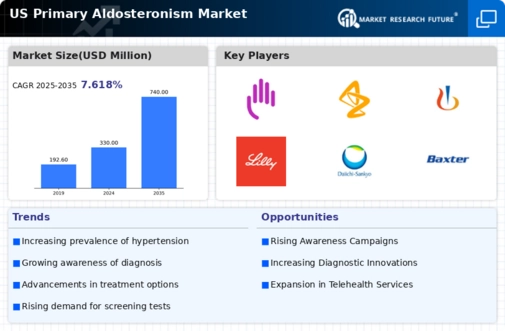Increasing Incidence of Hypertension
The rising incidence of hypertension in the US is a critical driver for the primary aldosteronism market. Studies indicate that approximately 30-40% of patients with hypertension may have primary aldosteronism, which often goes undiagnosed. As awareness of hypertension increases, healthcare providers are more likely to screen for underlying causes, including primary aldosteronism. This trend is expected to boost the demand for diagnostic tests and treatment options within the primary aldosteronism market. Furthermore, the prevalence of hypertension is projected to rise, with estimates suggesting that by 2030, nearly 50% of adults in the US will be affected. This growing patient population will likely necessitate more comprehensive management strategies, thereby driving market growth.
Rising Demand for Personalized Medicine
The rising demand for personalized medicine is reshaping the primary aldosteronism market. Patients increasingly seek tailored treatment options that consider their unique genetic and biochemical profiles. This trend is particularly relevant in the management of primary aldosteronism, where individual responses to treatment can vary significantly. Pharmaceutical companies are investing in research to develop targeted therapies that address the specific needs of patients with primary aldosteronism. As personalized medicine continues to gain traction, it is likely to enhance treatment efficacy and patient satisfaction, thereby propelling growth in the primary aldosteronism market.
Increased Focus on Preventive Healthcare
An increased focus on preventive healthcare is emerging as a significant driver for the primary aldosteronism market. As healthcare providers emphasize early detection and management of chronic conditions, screening for primary aldosteronism is becoming more common. Preventive strategies aim to reduce the long-term complications associated with untreated primary aldosteronism, such as cardiovascular diseases. This shift towards preventive care is supported by public health initiatives and educational campaigns that raise awareness about the importance of regular health check-ups. Consequently, the primary aldosteronism market is likely to benefit from this proactive approach, leading to higher rates of diagnosis and treatment.
Technological Advancements in Diagnostic Tools
Technological advancements in diagnostic tools are significantly influencing the primary aldosteronism market. Innovations such as improved imaging techniques and more sensitive hormonal assays have enhanced the ability to diagnose primary aldosteronism accurately. For instance, the introduction of non-invasive tests has made it easier for clinicians to identify patients at risk. The market for diagnostic devices is projected to grow at a CAGR of around 8% over the next five years, reflecting the increasing demand for efficient diagnostic solutions. As healthcare providers adopt these advanced technologies, the primary aldosteronism market is likely to expand, offering new opportunities for manufacturers and healthcare professionals alike.
Growing Investment in Healthcare Infrastructure
The growing investment in healthcare infrastructure in the US is a notable driver for the primary aldosteronism market. Increased funding for healthcare facilities and services has led to enhanced access to diagnostic and treatment options for patients. This investment is particularly evident in urban areas, where specialized clinics for endocrine disorders are emerging. As healthcare systems evolve, the integration of multidisciplinary approaches to manage conditions like primary aldosteronism becomes more feasible. The US government has allocated substantial resources to improve healthcare delivery, which is expected to facilitate better patient outcomes and drive the primary aldosteronism market forward.























Leave a Comment